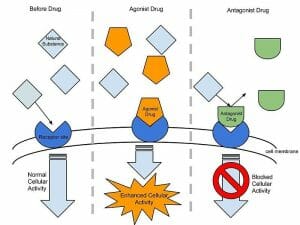Agonist Definition
An agonist is a molecule that can bind and activate a receptor to induce a biological reaction. The activity mediated by agonists are opposed by antagonists, which inhibit the biological response induced by an agonist. The level of agonist required to induce a desired biological response is referred to as potency. Agonist potency is derived by measuring the concentration of agonist required to induce half of the maximum response, called the EC50 value. Therefore, agonists with greater potency will have smaller EC50 values. Agonist potency is often calculated in the pharmaceutical industry, as the dosage for drugs that act as agonists is dependent on the EC50. The diagram below demonstrates the difference between naturally occurring agonists, the potency of drug agonists, and the inhibition of agonist effects via antagonists.
Types of Agonists
There are several types of agonists, which include endogenous, exogenous, physiological, superagonists, full, partial, inverse, irreversible, selective, and co-agonists. Each type of agonist exhibits different characteristics and mediates distinct biological activity.
Endogenous and Exogenous Agonists
Endogenous agonists constitute internal factors which induce a biological response. Some examples of endogenous agonists include hormones and neurotransmitters, which bind to defined receptors and induce a desired response. In contrast, exogenous agonists are external factors which bind to various receptors and induce a biological response. An example of an exogenous agonist is a drug, such as synthetic dopamine, which binds to the dopamine receptor and elicits a response analogous to endogenous dopamine signaling.
Physiological Agonists
Physiological agonists are agonists which can induce the same biological response; however, they do not bind to the same receptor. An example of this type of agonist is the activation of NF-kappa B by both cytokines (Interleukin [IL]-6, IL-1, and tumor necrosis factor) and environmental stimuli (e.g., bacterial lipopolysaccharides) via signaling through the associated cytokine receptors and pathogen recognition receptors, respectively.
Superagonists
A superagonist is an agonist capable of eliciting a biological response that is greater than the effect generated when the endogenous agonist binds to the receptor. The most common form of superagonists are drugs. For example, TGN1412 is a superagonist of CD28, resulting in the polyclonal activation of T cells and is associated with the risk of pathogenic cytokine production if used at a high dose.
Full versus Partial Agonists
Full agonists are able to fully bind to and activate their cognate receptor, thereby inducing the complete response capable of that receptor. In contrast, partial agonists also bind to the cognate receptor; however, they only induce a partial response. Partial agonists are useful for the treatment and avoidance of drug dependencies, as they induce a similar effect, albeit less potent and addictive. An example is the use of buprenorphine as an alternative for opiates (e.g., morphine) as it only partially engages the opioid receptor, thus reducing the likelihood of opiate addiction.
Inverse Agonists
An inverse agonist binds to the same receptor as an agonist; however, it exerts the opposite biological response of an agonist. An inverse agonist differs from an antagonist in that rather than simply inhibiting the response of the agonist, the opposing response is induced.
Irreversible Agonists
Irreversible agonists are agonists that form a permanent association with a receptor via the formation of covalent bonds. Some of the most well-characterized irreversible agonists are μ-opioid receptor agonists, such as naloxazone and oxymorphazone.
Selective Agonists
Selective agonists are specific to a particular receptor. For example, IFN-gamma is a selective agonist of the IFN-gamma receptor.
Co-agonists
A co-agonist requires the combination of two or more agonists to elicit a particular biological response. For example, the activation of infected macrophages to produce nitric oxide is dependent on the binding of bacterial ligands, IFN-gamma, and TNF, to their respective receptors.
Quiz
1. An agonist with a high EC50 is associated with:
A. A high dosage is required for optimal effect
B. A low potency
C. A low dosage is required for optimal effect
D. A high potency
E. A and B
F. A and D
2. Molecule A binds to Receptor A and Molecule B binds to Receptor B. Both agonists elicit response C. This is an example of what type of agonist?
A. Inverse agonists
B. Co-agonists
C. Physiological agonists
D. Partial agonists
References
- Workman LM, LaCharity LA, and Kruchko, S. (2011). Understanding Pharmacology: Essentials for Medication Safety. Elsevier Saunders: St. Louis, Missouri.
- Yu XX and Fernandez HH. (2017). Dopamine agonist withdrawal syndrome: A comprehensive review. J Neurol Sci.374:53-55.

